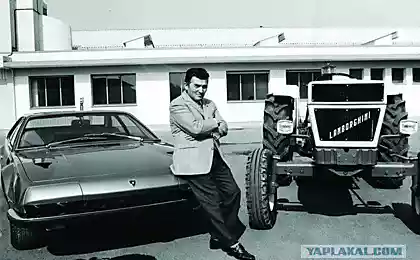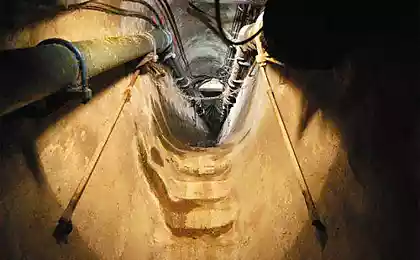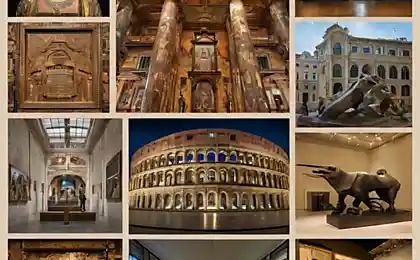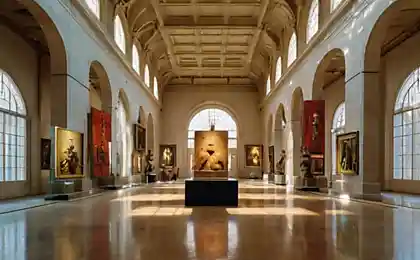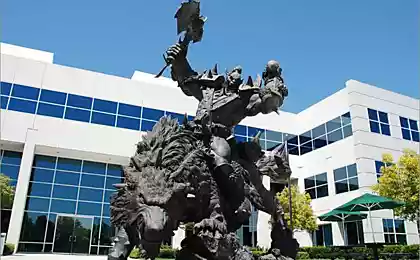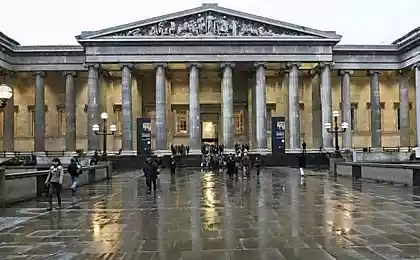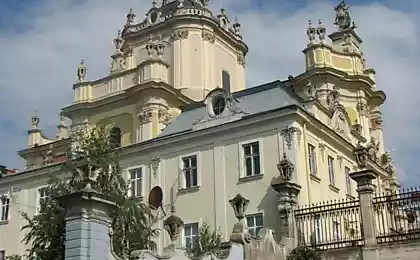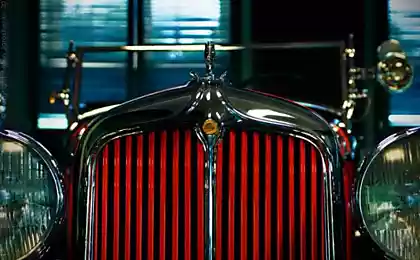990
Lamborghini Museum
1. Museo Automobili Lamborghini
Remembering the Italian supercars head is drawn not only to the image of the prancing horse, but, of course, the terrible bull, emblazoned on posters Lamborghini. Being the home of the car, I just had to stop in the museum Lamborghini. Moreover, the factory production of "Lambo" is just 35 km from the Ferrari factory in a place called Sant'Agata Bolognese near Bologna.
So, sit back! I will tell you and show you a large part of the history of the brand Lamborghini.
In contrast to Maranello, where whole buses bring tourists where every street is literally screaming that there produces Ferrari in Sant'Agata there is nothing similar. Small track wag of a typical Italian village which is close to the center turns into a small town, much of which takes the factory. After having wandered little bit, we find the entrance to the parking lot. The new facade building built recently, and it cost the concern VW (which owns the brand Lamborghini) $ 25 million. Here are located plant management, sales offices, boutique, where for 80 euros you can buy a teddy corporate bull.
But most importantly, that all of the judges avtoistorii must thank the German concern is that all the right wing of the building given to the museum Lamborghini.
VIA

2.2. But before all of the most valuable exhibits modestly huddled in one of the far corners of the shop. Decorated like a huge showcase, the museum allows you to see the exhibition already in the street. Entrance to the museum costs 11 euros, and another for 35 euros you can go through the factory and see with your own eyes on the production supercars. It would be very interesting, because here are collected not only the engines, but also all the nodes transmission, including limited slip differentials. The assembly is carried out slowly and by hand. But, unfortunately, for some unknown reason, the entrance to the factory was closed from the beginning of spring until the end of 2010, so we could not look at the production of unique vehicles, it is extremely rare in our time completely hand-built.
On site at the entrance to lure the few visitors, is a snow-white Lamborghini Gallardo Spider.
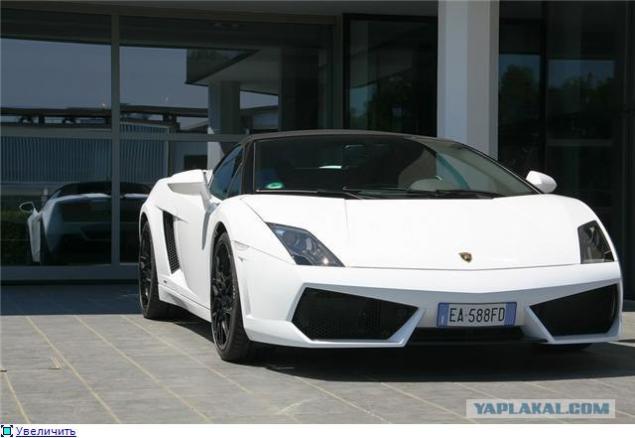
3. Slightly admiring it, go to the museum. The surprise was not the limit, because the room is empty ... ie. absolutely nobody, not even the cashier or manager. So we started inspection without paying for a ticket, and without permission. The museum consists of two large rooms on the first and second floors.
On the ground are located historically significant cars, starting with the 1960s,
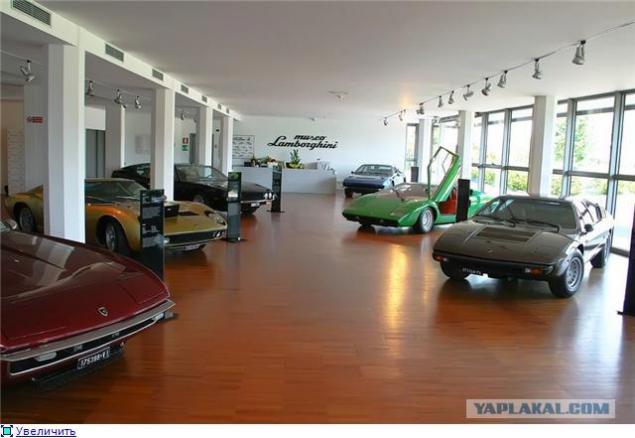
4. a second prototype and racing modifications.
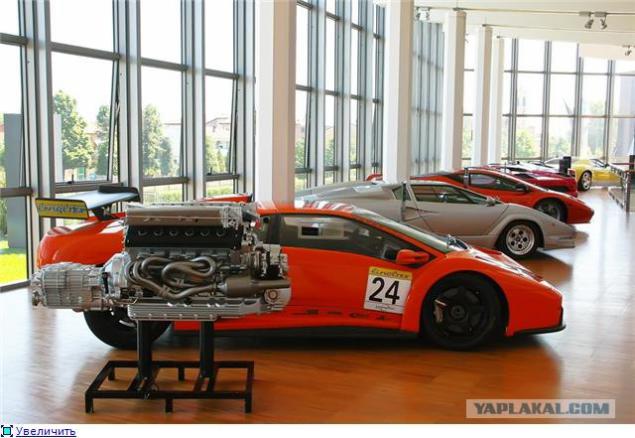
5. The appearance of the first supercar under the brand Lamborghini, which in those days was successfully produced tractors, indirectly had a hand in Enzo Ferrari himself. This fact is connected a beautiful story. In 1962, Ferruccio Lamborghini, being dissatisfied with constant problems with the clutch in a newly purchased Ferrari 365 GT, I came to Enzo Ferrari with constructive suggestions for troubleshooting. What Enzo replied rather sharply that he leave him alone, not bothered to engage in sports cars and returned to their tractors. After this conversation, resentful Lamborghini hurried home, drank a glass of wine to calm down, and on the same day sold his Ferrari. Just one year after the occurrence of the incident Ferruccio Lamborghini and founded the factory started the production of its own model of Lamborghini 350 GTV, decorated with the emblem of a furious bull, far superior to the aggressiveness of the symbol of Ferrari.
The exhibition begins with the first production car in the history of the brand - Lamborghini 350 GT 1964, which is a modified Lamborghini 350 GTV prototype in 1963.

6. he is behind
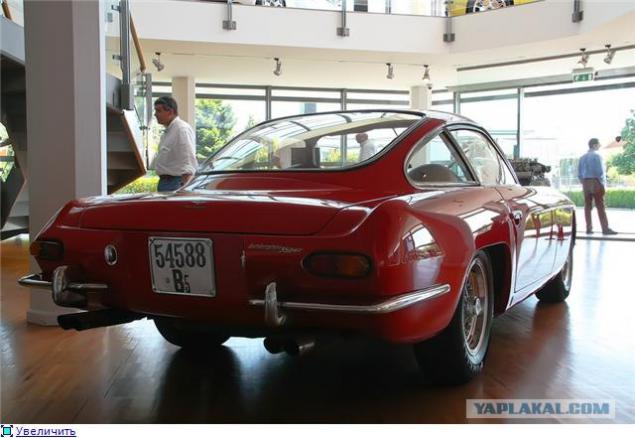
7. Then you can see a model of Lamborghini 400 GT (2 +2) in 1966 with a larger engine capacity and added rear seat.
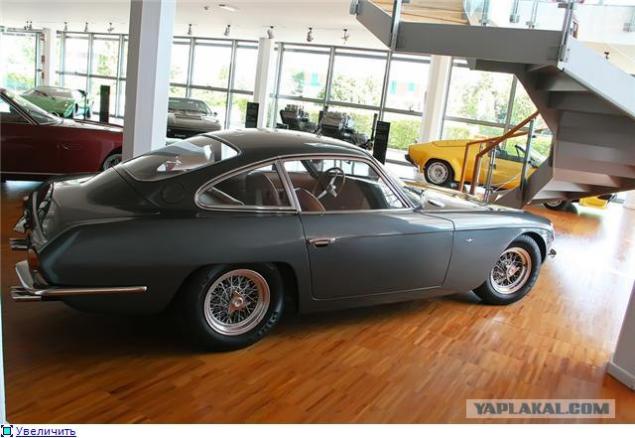
8. uhhh!
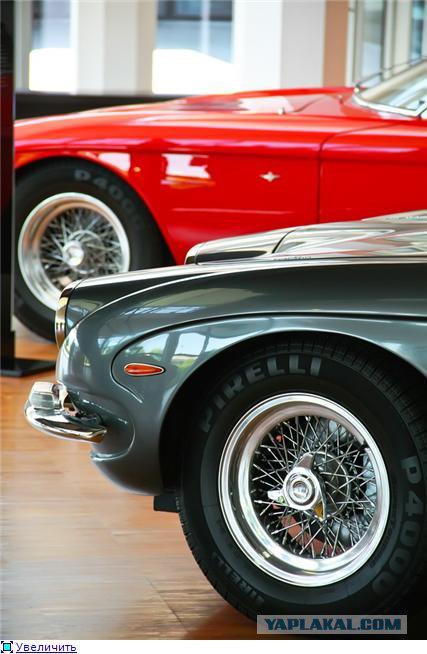
9. He also

10. He also
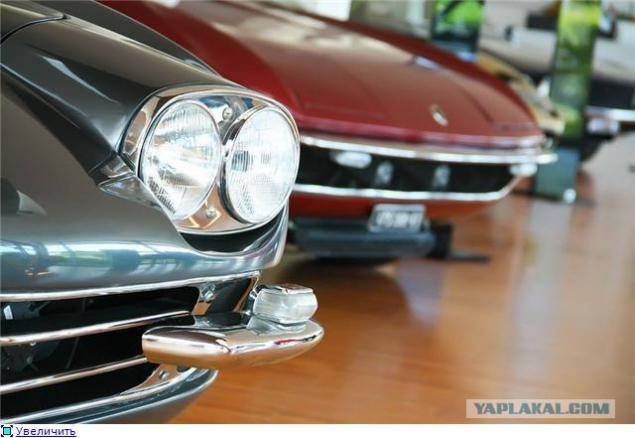
11. Next put on display a pair of first engine V12, which already had an aluminum block, equipped with six Weber carburetors and had a capacity of more than 300 hp, the first
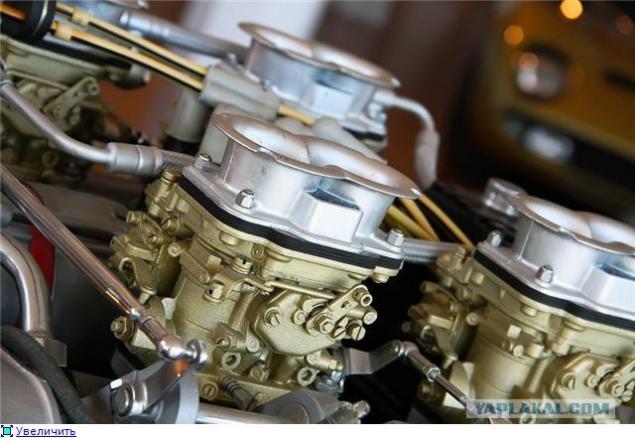
12. The second and
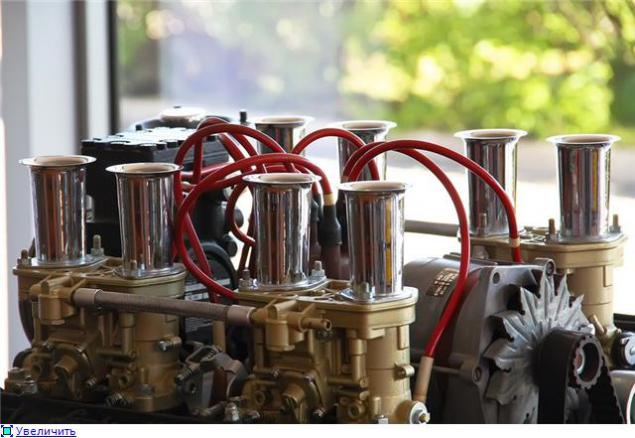
13. Then, to replace the 400 GT model comes Lamborghini Islero 1968, which gave rise to the tradition of calling the next model after famous bulls, participated in a bullfight or breeders.
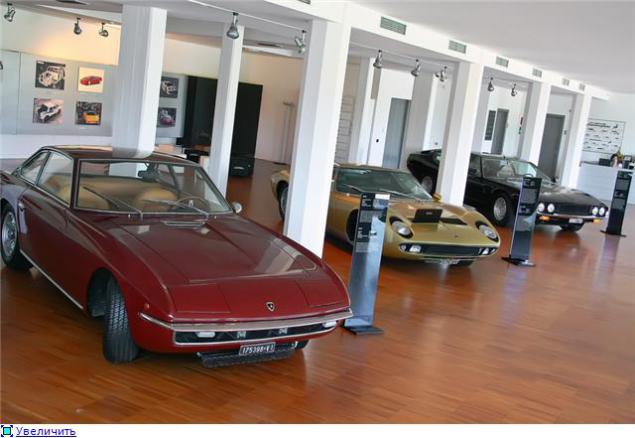
14. closer
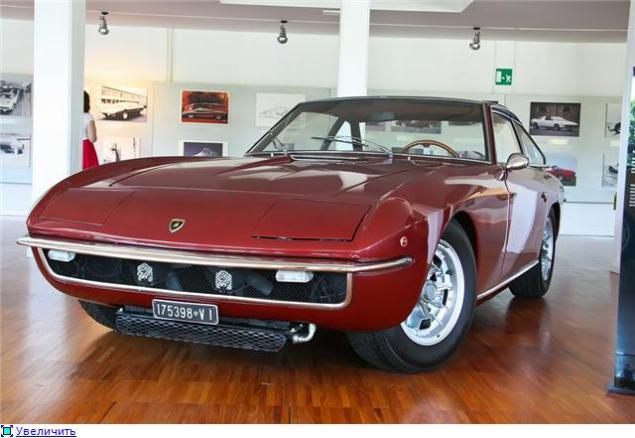
15. In the same year there is a roomy Lamborghini Espada 1968, the ability to quickly and comfortably carry four passengers.
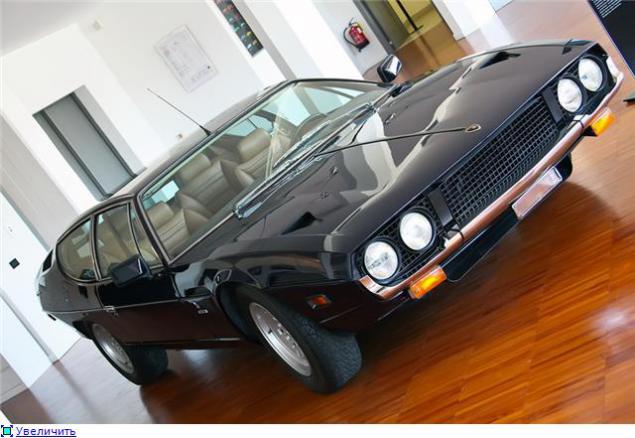
16. The hood
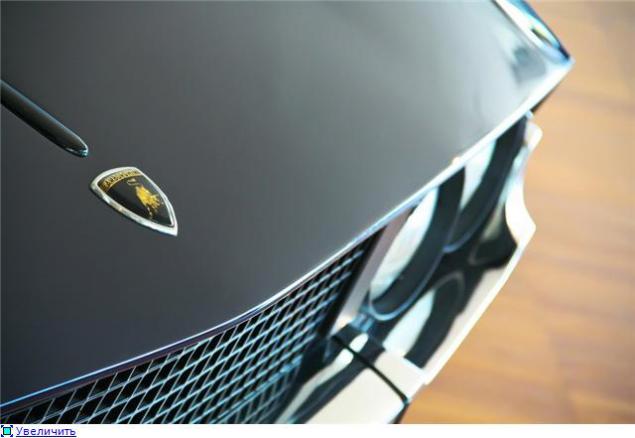
17. In place of the Islero comes exhibited in the corner Lamborghini Jarama 400 GT 2 + February 1970.
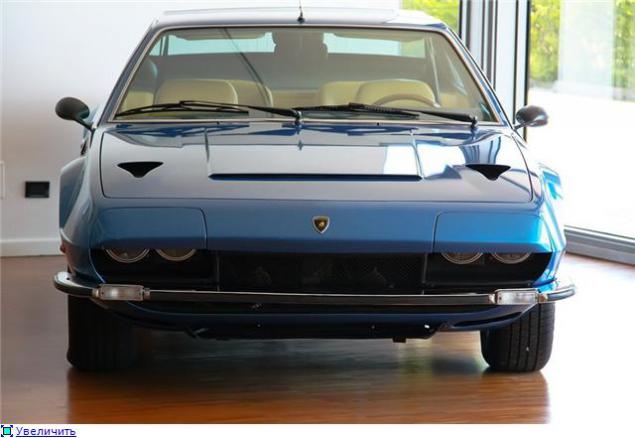
18. The left side

19. On the bottom of the intake!
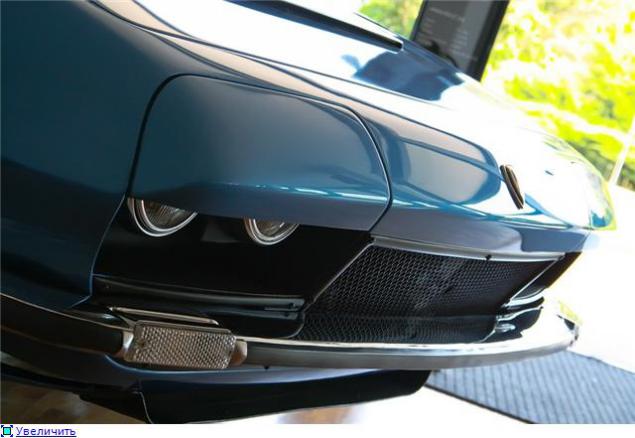
20. Next flaunts model Lamborghini Miura P400 S 1969, developed in secret by the owner of the company, because Ferruccio basically did not want to race - both real and racing development. This model has brought the Italian company a truly global fame. It accelerates from 0 to 100 km / h in 5, 7 seconds and the top speed was above 270 km / h. And it is at the end of the 60s of the last century!
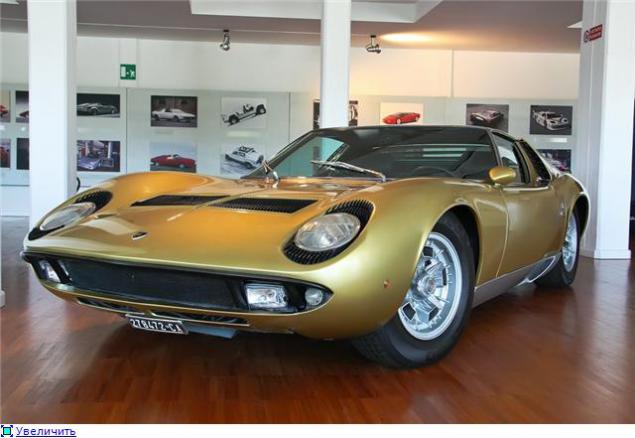
21. He
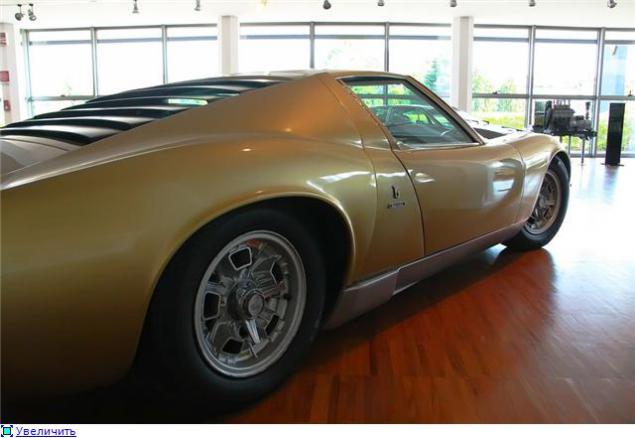
22. Yeah, such a form of hard drives otbalansirovat))
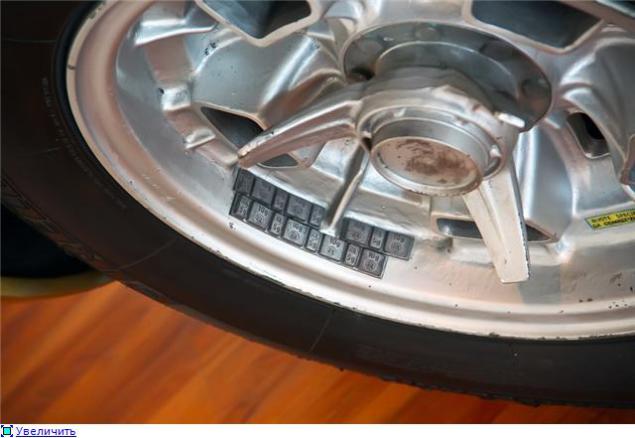
23. However, in a few years the production of Miura stops because the plant needed additional capacity for the production of perhaps the most legendary - Countach. The museum version of the Lamborghini Countach LP400 1974 bright green color.
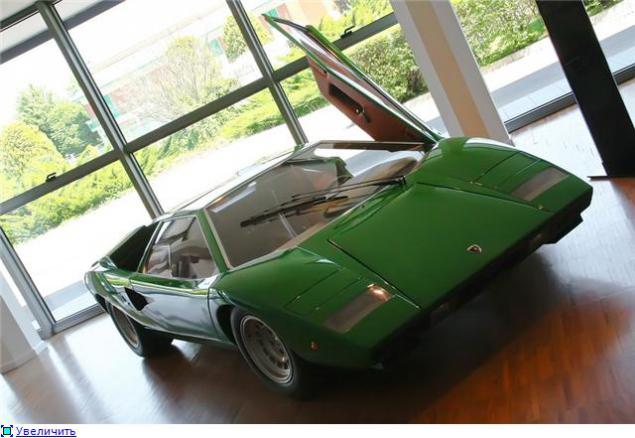
24. Dashboard
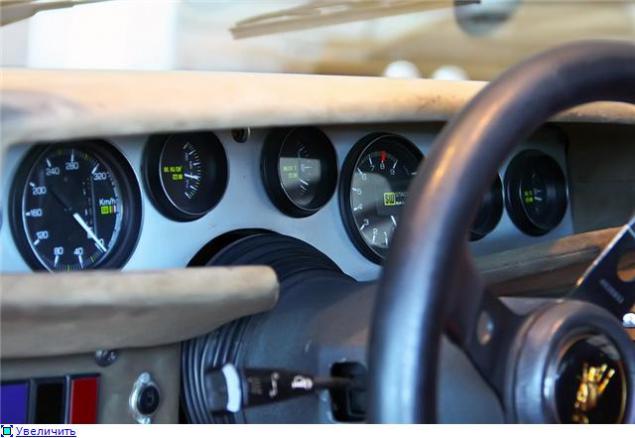
25. The popular supercar produced for almost 20 years: the premiere took place in 1971, and the last cars were collected in 1990. This model was first applied futuristic "guillotine" door, then become the hallmark of the brand. In the early 70s the company from investors bought Ferruccio Georges-Henri Rossetti and René Leimer, but just a few years Lamborghini declared bankrupt, because car sales, including sports, significantly decreased due to the global oil crisis. Therefore, the new management of the company decides to produce cheaper cars with engines smaller volume. Confirmation of this decision are two models - Lamborghini Jalpa 1981, has become one of the most popular and cheapest model in the history of the brand, and Lamborghini P 250 Urraco 1972, equipped with a small engine V8

26. In the early 80's bought a Lamborghini Mimra brothers from Switzerland, and then, in 1987, control of the company passed to the North American corporation Chrysler, which has managed to bring back the Italian brand worldwide fame. In the late 80s it was time to develop a new supercar to replace the successful, but already obsolete Countach. The result was the appearance of the model Diablo, which was presented in early 1990. The car was all-wheel drive, and 5, 7-liter engine gave out 492 hp For 11 years, it has sold nearly 3000 different modifications Diablo. In 1998 it was the last for the moment a change of owner - the Italian company bought the Audi AG, which is part of the concern Volkswagen.
Salons many earlier models were a pitiful sight,
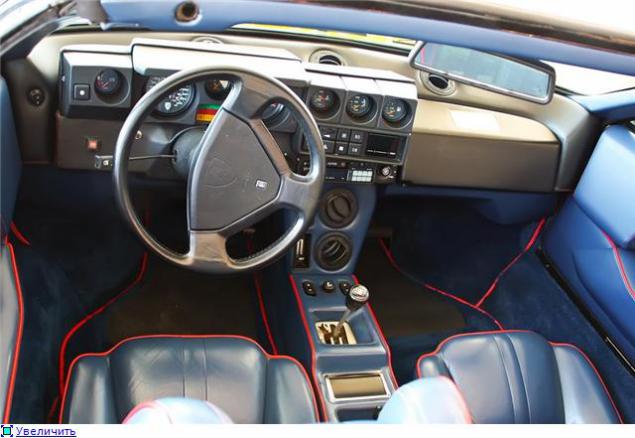
27 but with the music!
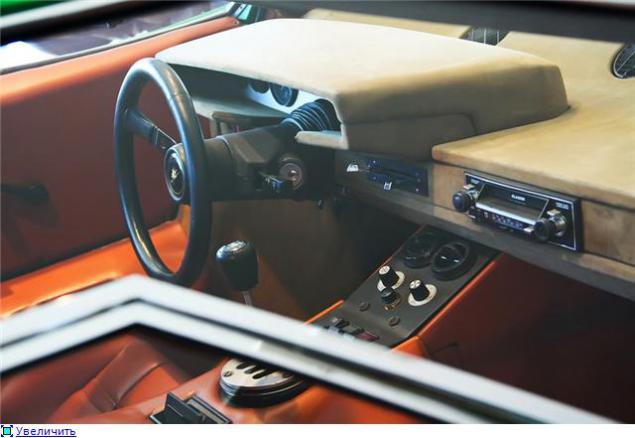
28. and skin!
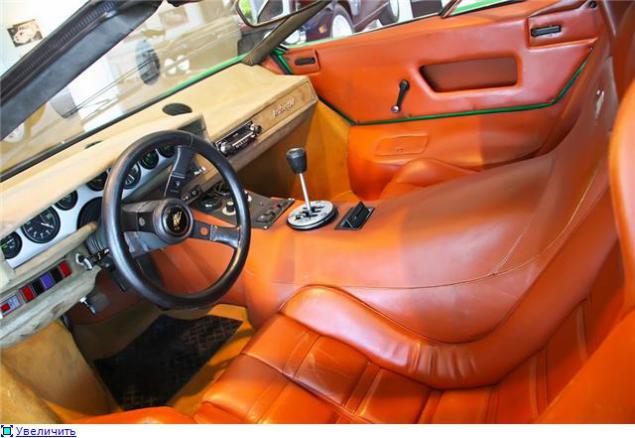
29. but as a result of the joint work of the Italian-German quality materials and workmanship has improved significantly.
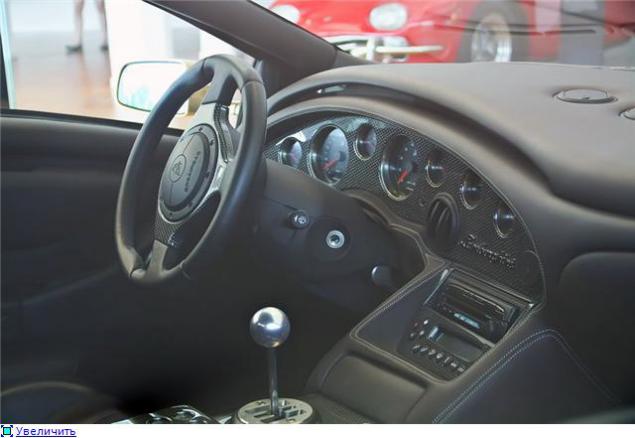
30. Well straight Porsche.
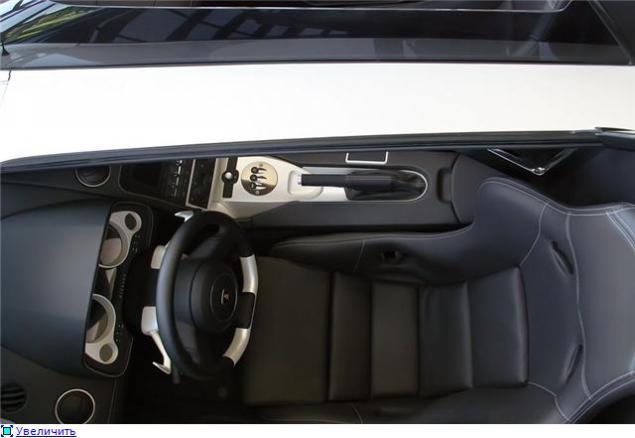
31. Completes the exposure of the first floor is the latest modification of the Diablo, created already under the control of Audi - Lamborghini Diablo VT 6.0 SE 2001
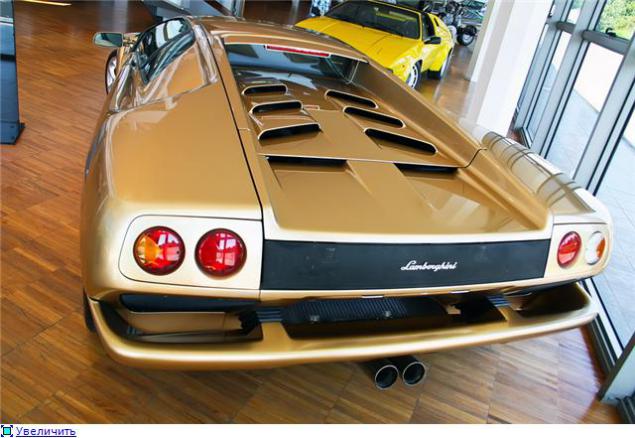
32. The front and
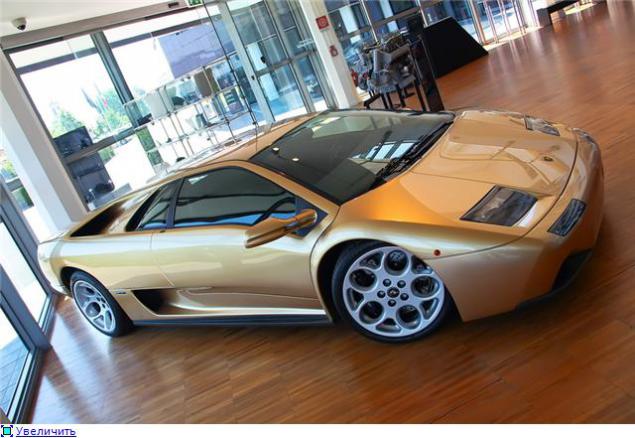
33. The car exhibited on the ground floor you can see a lot of photos and video presentations as well as the old factory tools.
Especially liked the funny pictures with the inscription - WELCOME TO SANT 'AGATA BOLOGNESE, HOME OF LAMBORGHINI.

34. Go up to the second floor and literally fall into a stupor, because right next to the stairs in the middle of the hall is incredible, futuristic Lamborghini Reventon, 2009, from which it is simply impossible to look away, considering the amazing magic of lines and contours of the body. Now, seeing him live, I can safely say that this is the most beautiful car in the world!

35. The label ...
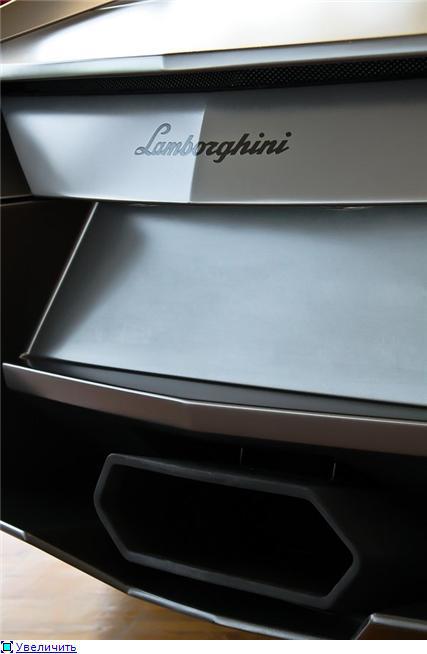
36. rear view
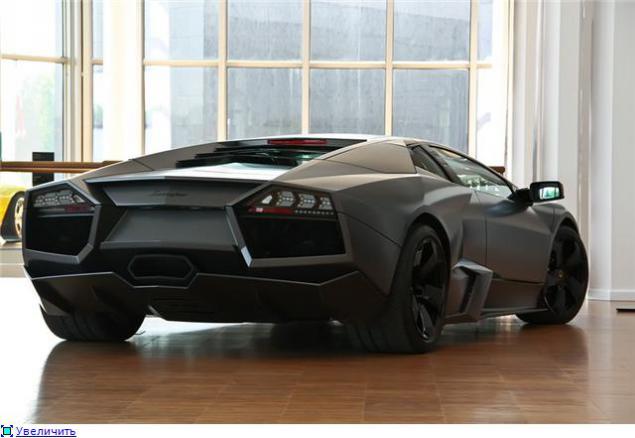
37. What line! Wah!
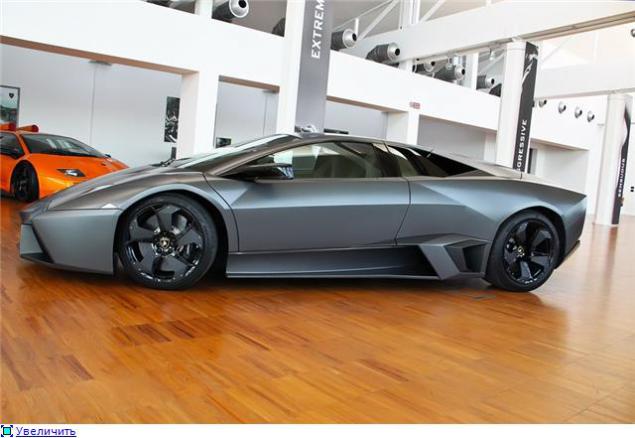
38. through the gills engine
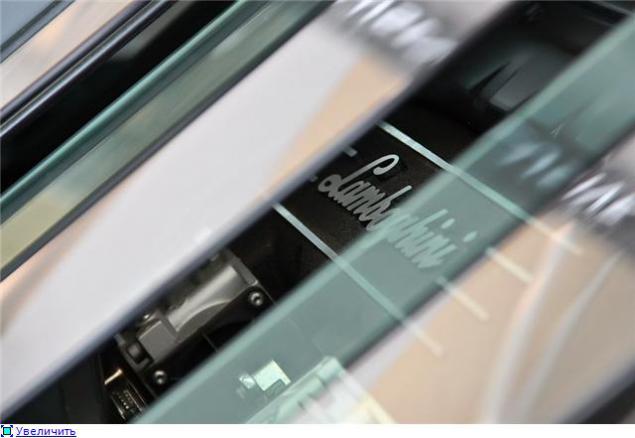
39. Reventon - the latest innovation of the brand, which will be set up just 20 copies, plus the first, located in the museum, as a serial number 00/20. The cost of each instance is equal to one million euros.
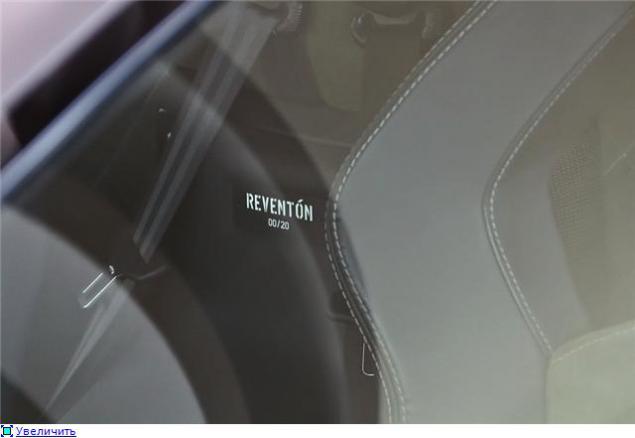
40. Next we see seemingly ordinary Lamborghini Murcielago 2001, but surprisingly does not pass, because it is suspended on the wall!
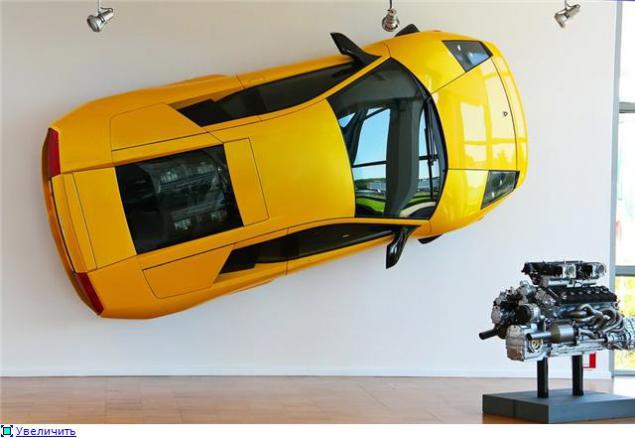
41. Front

42. The engine behind the glass
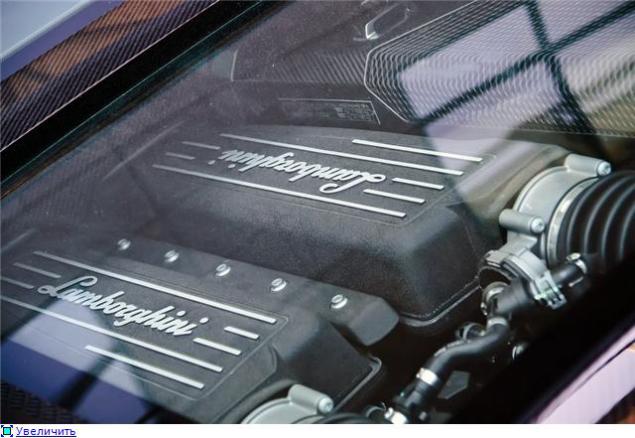
43. Turning again to admire the exclusive Reventon, but it is time to go further, where there are two race "Devil" - Lamborghini Diablo GT 1998, created to participate in the 24-hour race at Le Mans
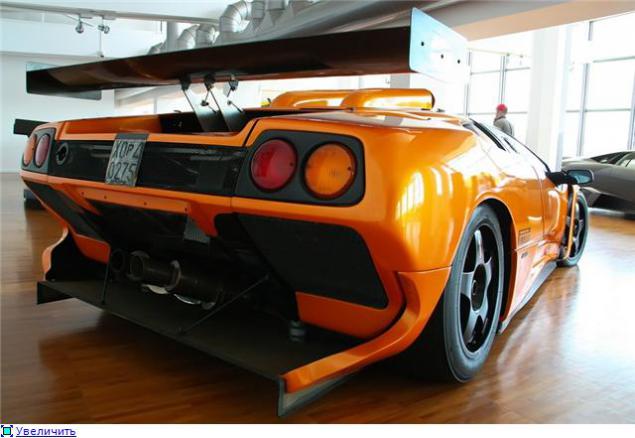
44. The only sport
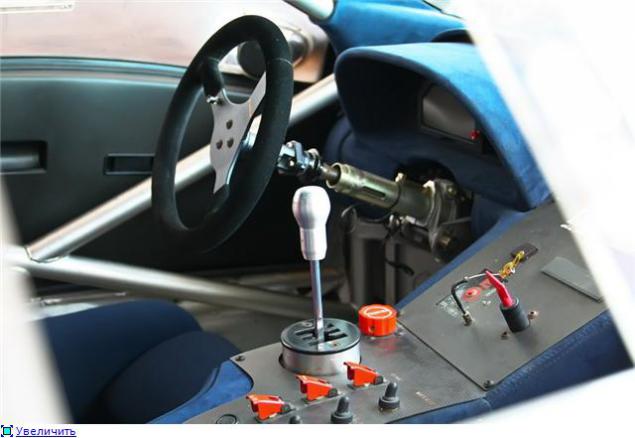
45. Nothing in excess!

46. Momo, where do without him ...

Source:
Remembering the Italian supercars head is drawn not only to the image of the prancing horse, but, of course, the terrible bull, emblazoned on posters Lamborghini. Being the home of the car, I just had to stop in the museum Lamborghini. Moreover, the factory production of "Lambo" is just 35 km from the Ferrari factory in a place called Sant'Agata Bolognese near Bologna.
So, sit back! I will tell you and show you a large part of the history of the brand Lamborghini.
In contrast to Maranello, where whole buses bring tourists where every street is literally screaming that there produces Ferrari in Sant'Agata there is nothing similar. Small track wag of a typical Italian village which is close to the center turns into a small town, much of which takes the factory. After having wandered little bit, we find the entrance to the parking lot. The new facade building built recently, and it cost the concern VW (which owns the brand Lamborghini) $ 25 million. Here are located plant management, sales offices, boutique, where for 80 euros you can buy a teddy corporate bull.
But most importantly, that all of the judges avtoistorii must thank the German concern is that all the right wing of the building given to the museum Lamborghini.
VIA

2.2. But before all of the most valuable exhibits modestly huddled in one of the far corners of the shop. Decorated like a huge showcase, the museum allows you to see the exhibition already in the street. Entrance to the museum costs 11 euros, and another for 35 euros you can go through the factory and see with your own eyes on the production supercars. It would be very interesting, because here are collected not only the engines, but also all the nodes transmission, including limited slip differentials. The assembly is carried out slowly and by hand. But, unfortunately, for some unknown reason, the entrance to the factory was closed from the beginning of spring until the end of 2010, so we could not look at the production of unique vehicles, it is extremely rare in our time completely hand-built.
On site at the entrance to lure the few visitors, is a snow-white Lamborghini Gallardo Spider.

3. Slightly admiring it, go to the museum. The surprise was not the limit, because the room is empty ... ie. absolutely nobody, not even the cashier or manager. So we started inspection without paying for a ticket, and without permission. The museum consists of two large rooms on the first and second floors.
On the ground are located historically significant cars, starting with the 1960s,

4. a second prototype and racing modifications.

5. The appearance of the first supercar under the brand Lamborghini, which in those days was successfully produced tractors, indirectly had a hand in Enzo Ferrari himself. This fact is connected a beautiful story. In 1962, Ferruccio Lamborghini, being dissatisfied with constant problems with the clutch in a newly purchased Ferrari 365 GT, I came to Enzo Ferrari with constructive suggestions for troubleshooting. What Enzo replied rather sharply that he leave him alone, not bothered to engage in sports cars and returned to their tractors. After this conversation, resentful Lamborghini hurried home, drank a glass of wine to calm down, and on the same day sold his Ferrari. Just one year after the occurrence of the incident Ferruccio Lamborghini and founded the factory started the production of its own model of Lamborghini 350 GTV, decorated with the emblem of a furious bull, far superior to the aggressiveness of the symbol of Ferrari.
The exhibition begins with the first production car in the history of the brand - Lamborghini 350 GT 1964, which is a modified Lamborghini 350 GTV prototype in 1963.

6. he is behind

7. Then you can see a model of Lamborghini 400 GT (2 +2) in 1966 with a larger engine capacity and added rear seat.

8. uhhh!

9. He also

10. He also

11. Next put on display a pair of first engine V12, which already had an aluminum block, equipped with six Weber carburetors and had a capacity of more than 300 hp, the first

12. The second and

13. Then, to replace the 400 GT model comes Lamborghini Islero 1968, which gave rise to the tradition of calling the next model after famous bulls, participated in a bullfight or breeders.

14. closer

15. In the same year there is a roomy Lamborghini Espada 1968, the ability to quickly and comfortably carry four passengers.

16. The hood

17. In place of the Islero comes exhibited in the corner Lamborghini Jarama 400 GT 2 + February 1970.

18. The left side

19. On the bottom of the intake!

20. Next flaunts model Lamborghini Miura P400 S 1969, developed in secret by the owner of the company, because Ferruccio basically did not want to race - both real and racing development. This model has brought the Italian company a truly global fame. It accelerates from 0 to 100 km / h in 5, 7 seconds and the top speed was above 270 km / h. And it is at the end of the 60s of the last century!

21. He

22. Yeah, such a form of hard drives otbalansirovat))

23. However, in a few years the production of Miura stops because the plant needed additional capacity for the production of perhaps the most legendary - Countach. The museum version of the Lamborghini Countach LP400 1974 bright green color.

24. Dashboard

25. The popular supercar produced for almost 20 years: the premiere took place in 1971, and the last cars were collected in 1990. This model was first applied futuristic "guillotine" door, then become the hallmark of the brand. In the early 70s the company from investors bought Ferruccio Georges-Henri Rossetti and René Leimer, but just a few years Lamborghini declared bankrupt, because car sales, including sports, significantly decreased due to the global oil crisis. Therefore, the new management of the company decides to produce cheaper cars with engines smaller volume. Confirmation of this decision are two models - Lamborghini Jalpa 1981, has become one of the most popular and cheapest model in the history of the brand, and Lamborghini P 250 Urraco 1972, equipped with a small engine V8

26. In the early 80's bought a Lamborghini Mimra brothers from Switzerland, and then, in 1987, control of the company passed to the North American corporation Chrysler, which has managed to bring back the Italian brand worldwide fame. In the late 80s it was time to develop a new supercar to replace the successful, but already obsolete Countach. The result was the appearance of the model Diablo, which was presented in early 1990. The car was all-wheel drive, and 5, 7-liter engine gave out 492 hp For 11 years, it has sold nearly 3000 different modifications Diablo. In 1998 it was the last for the moment a change of owner - the Italian company bought the Audi AG, which is part of the concern Volkswagen.
Salons many earlier models were a pitiful sight,

27 but with the music!

28. and skin!

29. but as a result of the joint work of the Italian-German quality materials and workmanship has improved significantly.

30. Well straight Porsche.

31. Completes the exposure of the first floor is the latest modification of the Diablo, created already under the control of Audi - Lamborghini Diablo VT 6.0 SE 2001

32. The front and

33. The car exhibited on the ground floor you can see a lot of photos and video presentations as well as the old factory tools.
Especially liked the funny pictures with the inscription - WELCOME TO SANT 'AGATA BOLOGNESE, HOME OF LAMBORGHINI.

34. Go up to the second floor and literally fall into a stupor, because right next to the stairs in the middle of the hall is incredible, futuristic Lamborghini Reventon, 2009, from which it is simply impossible to look away, considering the amazing magic of lines and contours of the body. Now, seeing him live, I can safely say that this is the most beautiful car in the world!

35. The label ...

36. rear view

37. What line! Wah!

38. through the gills engine

39. Reventon - the latest innovation of the brand, which will be set up just 20 copies, plus the first, located in the museum, as a serial number 00/20. The cost of each instance is equal to one million euros.

40. Next we see seemingly ordinary Lamborghini Murcielago 2001, but surprisingly does not pass, because it is suspended on the wall!

41. Front

42. The engine behind the glass

43. Turning again to admire the exclusive Reventon, but it is time to go further, where there are two race "Devil" - Lamborghini Diablo GT 1998, created to participate in the 24-hour race at Le Mans

44. The only sport

45. Nothing in excess!

46. Momo, where do without him ...

Source:

